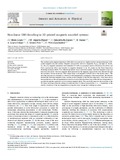Mostrar el registro sencillo del ítem
Non-linear GMI decoding in 3D printed magnetic encoded systems
| dc.creator | Beato López, Juan Jesús | es_ES |
| dc.creator | Algueta-Miguel, Jose M. | es_ES |
| dc.creator | Galarreta Rodríguez, Itziar | es_ES |
| dc.creator | Garayo Urabayen, Eneko | es_ES |
| dc.creator | López Ortega, Alberto | es_ES |
| dc.creator | Gómez Polo, Cristina | es_ES |
| dc.creator | Pérez de Landazábal Berganzo, José Ignacio | es_ES |
| dc.date.accessioned | 2023-06-14T15:44:28Z | |
| dc.date.available | 2023-06-14T15:44:28Z | |
| dc.date.issued | 2023 | |
| dc.identifier.citation | Beato-López, J. J., Algueta-Miguel, J. M., Galarreta-Rodriguez, I., Garaio, E., López-Ortega, A., Gómez-Polo, C., & Pérez-Landazábal, J. I. (2023). Non-linear GMI decoding in 3D printed magnetic encoded systems. Sensors and Actuators A: Physical, 358, 114447. https://doi.org/10.1016/j.sna.2023.114447 | en |
| dc.identifier.issn | 0924-4247 | |
| dc.identifier.uri | https://hdl.handle.net/2454/45498 | |
| dc.description.abstract | The nonlinear giant magnetoimpedance (GMI) effect was explored as a highly sensitive sensing technology in 3D-printed magnetic encoded systems. Magnetic nanoparticles with low (magnetite, Fe3O4) and high (Co ferrite, Co0.7Fe2.3O4) magnetic remanence were embedded (10 wt%) in a polymeric matrix of Polylactic Acid (PLA) and Poly-ε-caprolactone (PCL) and extruded in magnetic filaments to be 3D printed by the Fused Deposition Modelling technique (FDM). Two different geometries were constructed namely, individual magnetic strips and fixed barcoded pieces. The stray magnetic fields generated by the magnetic nanoparticles were detected through the non-linear (second harmonic) GMI voltage using a soft magnetic CoFeSiB wire as the nucleus sensor. The decoding response was analyzed as a function of the magnetization remanence of the nanoparticles, the distance between the individual magnetic strips, and the position (height) of the GMI decoding sensor. It has been shown that modification of the net magnetization direction of each individual fixed strip within the barcode geometry is possible through the application of local external magnetic fields. This possibility improves the versatility of the 3D binary encoding system by adding an additional state (0 without nanoparticles, 1 or −1 depending on the relative orientation of the net magnetization along the strips) during the codifying procedure. | en |
| dc.description.sponsorship | This work has been funded by the Gobierno de Navarra - Departamento de Desarrollo Económico within the framework of the Project: “Advanced Manufacturing of Electronics, AMELEC”. It has also been partially funded by the Spanish Government - Ministerio Ciencia - Innovación (PID2019-107258RB-C32 of MCIN/AEI/10.13039/501100011033) and from the grant PID2021–122613OB-I00 funded by MCIN/AEI/ 10.13039/501100011033. Open access funding is provided by Universidad Pública de Navarra. | en |
| dc.format.mimetype | application/pdf | en |
| dc.format.mimetype | application/msword | en |
| dc.language.iso | eng | en |
| dc.publisher | Elsevier | en |
| dc.relation.ispartof | Sensors and Actuators: A. Physical, 358 (2023) 114447 | en |
| dc.rights | © 2023 The Authors. This is an open access article under the CC BY-NC-ND license. | en |
| dc.rights.uri | http://creativecommons.org/licenses/by-nc-nd/4.0/ | |
| dc.subject | 3D printing | en |
| dc.subject | Polymer-matrix composites | en |
| dc.subject | Three states encoding information | en |
| dc.subject | Non-linear GMI effect | en |
| dc.subject | Magnetic sensor | en |
| dc.subject | Magnetization direction reversal | en |
| dc.title | Non-linear GMI decoding in 3D printed magnetic encoded systems | en |
| dc.type | Artículo / Artikulua | es |
| dc.type | info:eu-repo/semantics/article | en |
| dc.date.updated | 2023-06-14T15:30:22Z | |
| dc.contributor.department | Ciencias | es_ES |
| dc.contributor.department | Ingeniería Eléctrica, Electrónica y de Comunicación | es_ES |
| dc.contributor.department | Institute for Advanced Materials and Mathematics - INAMAT2 | en |
| dc.contributor.department | Institute of Smart Cities - ISC | en |
| dc.contributor.department | Zientziak | eu |
| dc.contributor.department | Ingeniaritza Elektrikoa, Elektronikoaren eta Telekomunikazio Ingeniaritzaren | eu |
| dc.rights.accessRights | Acceso abierto / Sarbide irekia | es |
| dc.rights.accessRights | info:eu-repo/semantics/openAccess | en |
| dc.identifier.doi | 10.1016/j.sna.2023.114447 | |
| dc.relation.projectID | info:eu-repo/grantAgreement/AEI/Plan Estatal de Investigación Científica y Técnica y de Innovación 2017-2020/PID2019-107258RB-C32/ES/ | en |
| dc.relation.projectID | info:eu-repo/grantAgreement/MCIN/AEI//PID2021-122613OB-I00 | en |
| dc.relation.projectID | info:eu-repo/grantAgreement/Gobierno de Navarra// | en |
| dc.relation.publisherversion | https://doi.org/10.1016/j.sna.2023.114447 | |
| dc.type.version | Versión publicada / Argitaratu den bertsioa | es |
| dc.type.version | info:eu-repo/semantics/publishedVersion | en |
| dc.contributor.funder | Universidad Pública de Navarra / Nafarroako Unibertsitate Publikoa | es |



